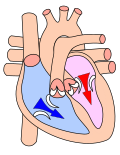The surface-area-to-volume ratio or surface-to-volume ratio (denoted as SA:V, SA/V, or sa/vol) is the ratio between surface area and volume of an object...
20 KB (2,134 words) - 08:24, 23 March 2024
to minimize surface area; for example, people will fold their arms over their chest when cold to minimize heat loss. The surface area to volume ratio...
15 KB (1,505 words) - 03:15, 26 April 2024
reactivity of a powder. However, it fails to measure much of the deep surface texture. Surface-area-to-volume ratio IUPAC, Compendium of Chemical Terminology...
7 KB (720 words) - 17:31, 21 January 2024
body surface-area-to-volume ratio for homeothermic animals varies with the average temperature of the habitat to which they are adapted (i.e. the ratio is...
13 KB (1,399 words) - 22:55, 10 May 2024
Square–cube law (category Volume)
cube has a surface area to volume ratio of (24/8) 3:1. As the dimensions increase, the volume will continue to grow faster than the surface area. Thus the...
13 KB (1,788 words) - 22:50, 28 February 2024
its surface area-to-volume ratio will decrease. Modeling a person's trunk and limbs as cylinders shows a 17% decrease in surface area-to-volume ratio from...
27 KB (3,024 words) - 16:46, 10 April 2024
ratio of surface membrane area to volume. This is also described as a "relative membrane excess." It is due to either increased red cell surface area...
6 KB (706 words) - 16:12, 15 January 2024
Gas exchange (section Diffusion and surface area)
larger organisms, which have small surface-area to volume ratios, specialised structures with convoluted surfaces such as gills, pulmonary alveoli and...
57 KB (6,610 words) - 06:22, 10 May 2024
Carbon black (category CS1: long volume value)
high surface-area-to-volume ratio, albeit lower than that of activated carbon. It is dissimilar to soot in its much higher surface-area-to-volume ratio and...
26 KB (2,877 words) - 07:30, 17 May 2024
length can be approximated by the volume of the ventricle because each shape has a conserved surface-area-to-volume ratio. This is useful clinically because...
6 KB (716 words) - 08:47, 4 February 2024










